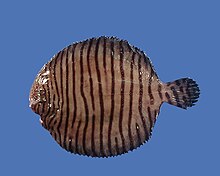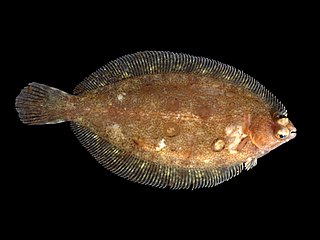
Microstomus is a genus of righteye flounders native to the northern Pacific and north-eastern Atlantic oceans.

Eopsetta is a genus of righteye flounders native to the northern Pacific Ocean.
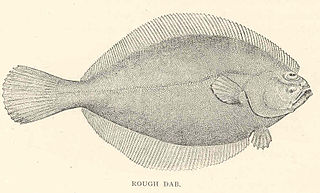
Hippoglossoides is a genus of righteye flounders native to the North Pacific and North Atlantic oceans.
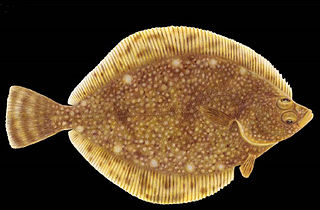
Lepidopsetta is a genus of righteye flounders native to the North Pacific Ocean.

Pleuronichthys is a genus of fish in the family Pleuronectidae found in the Pacific Ocean.

Achirus is a genus of American soles native to tropical and subtropical parts of the Americas. They are mainly found in coastal areas, including salt and brackish water, but some species are found in fresh water.

Apionichthys is a genus of mostly freshwater American soles native to South America.

Catathyridium is a genus of mainly freshwater American soles native to South America.

Hypoclinemus mentalis is a species of freshwater American sole native to the Amazon, Orinoco and Essequibo river basins in tropical South America. This species grows to a length of 21 cm (8.3 in). It is the only known species of its genus.
Pnictes asphyxiatus is a species of freshwater American sole known only from the Amazon Basin in Brazil. This species grows to a standard length of 9.6 cm (3.8 in). It is so far known from only one specimen. This species is the only known member of its genus, Pnictes.
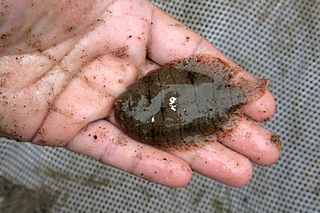
Trinectes is a genus of American soles native to the Americas. Most species are coastal, occurring in both salt and brackish water, but several may enter fresh water and one, T. hubbsbollinger, is restricted to rivers. They are fairly small, with the largest species only reaching 25 cm (9.8 in) in length.

Austroglossus is a genus of soles native to the Atlantic coast of southern Africa.

Dicologlossa is a genus of soles native to the tropical and subtropical eastern Atlantic Ocean.

Microchirus is a genus of soles native to the Eastern Atlantic Ocean and Mediterranean Sea.
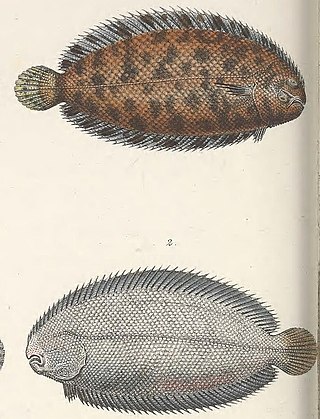
Monochirus is a genus of small soles. It contains two species; one from the northeast Atlantic and Mediterranean, and the second from the South China Sea.

Pegusa is a genus of soles native to the Eastern Atlantic Ocean, Mediterranean Sea, and Black Sea.
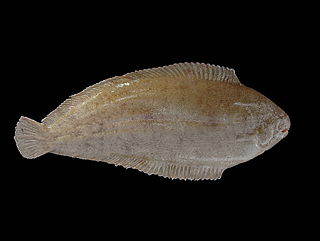
Solea is a genus of soles from the Indo-Pacific and East Atlantic Oceans, and the Mediterranean Sea.
Gymnachirus melas, the North American naked sole, also known as the naked sole, is a species of sole in the family Achiridae. It was described by John Treadwell Nichols in 1916. It is known from Mexico, Cuba, the Bahamas, and the United States. It dwells at a depth range of 2 to 185 m. It reaches a maximum length of 22 cm (8.7 in).
Gymnachirus nudus, the naked sole, also known as the flabby sole, is a species of sole in the family Achiridae. It was described by Johann Jakob Kaup in 1858. It is known from throughout the western Atlantic. It dwells on soft bottoms at a depth range of 2 to 100 m. It reaches a maximum total length of 15 cm (5.9 in), more commonly reaching a TL of 12 cm (4.7 in).
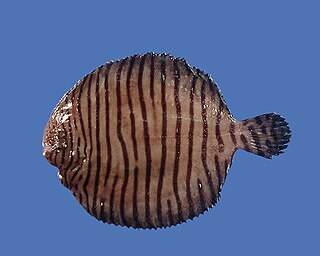
The Gulf of Mexico fringed sole, also known as the fringed sole, is a species of sole in the family Achiridae. It was described by Gordon Gunter in 1936, originally under the genus Nodogymnus. It is known from the United States and Mexico. It dwells at a depth range of 20 to 187 m. It reaches a maximum total length of 14 cm (5.5 in).
